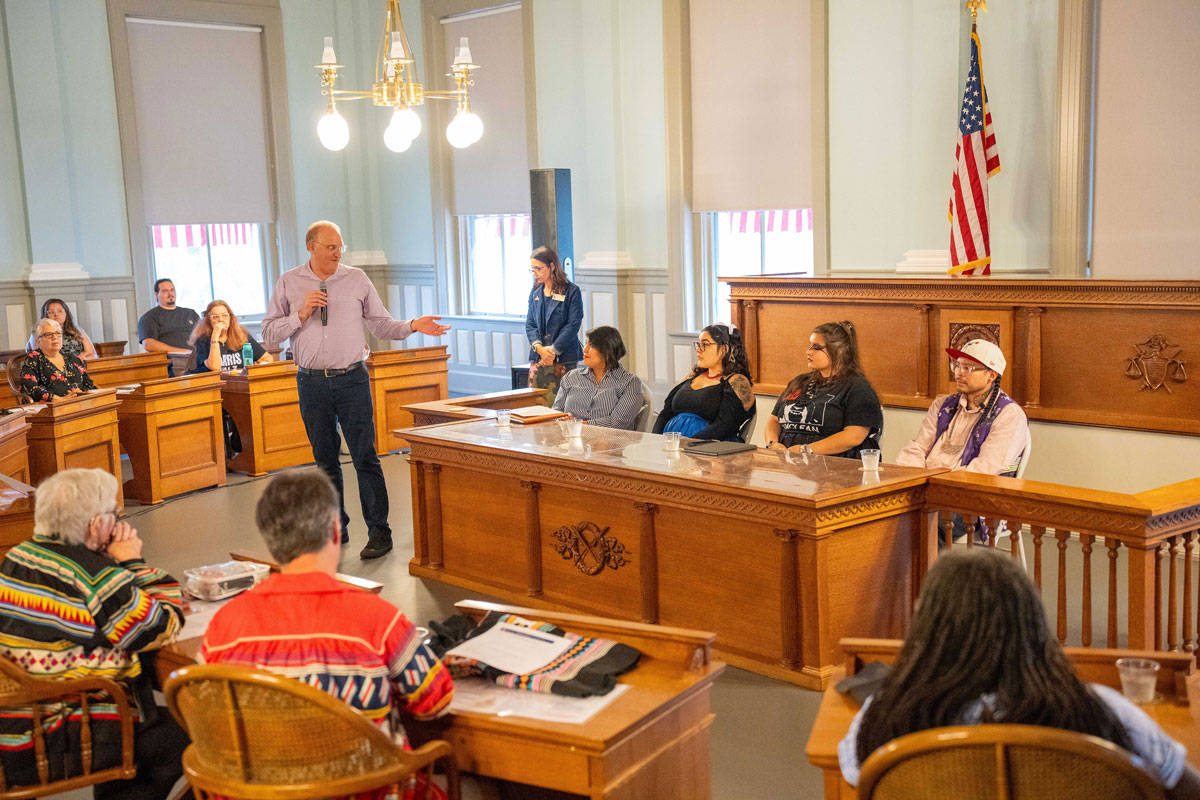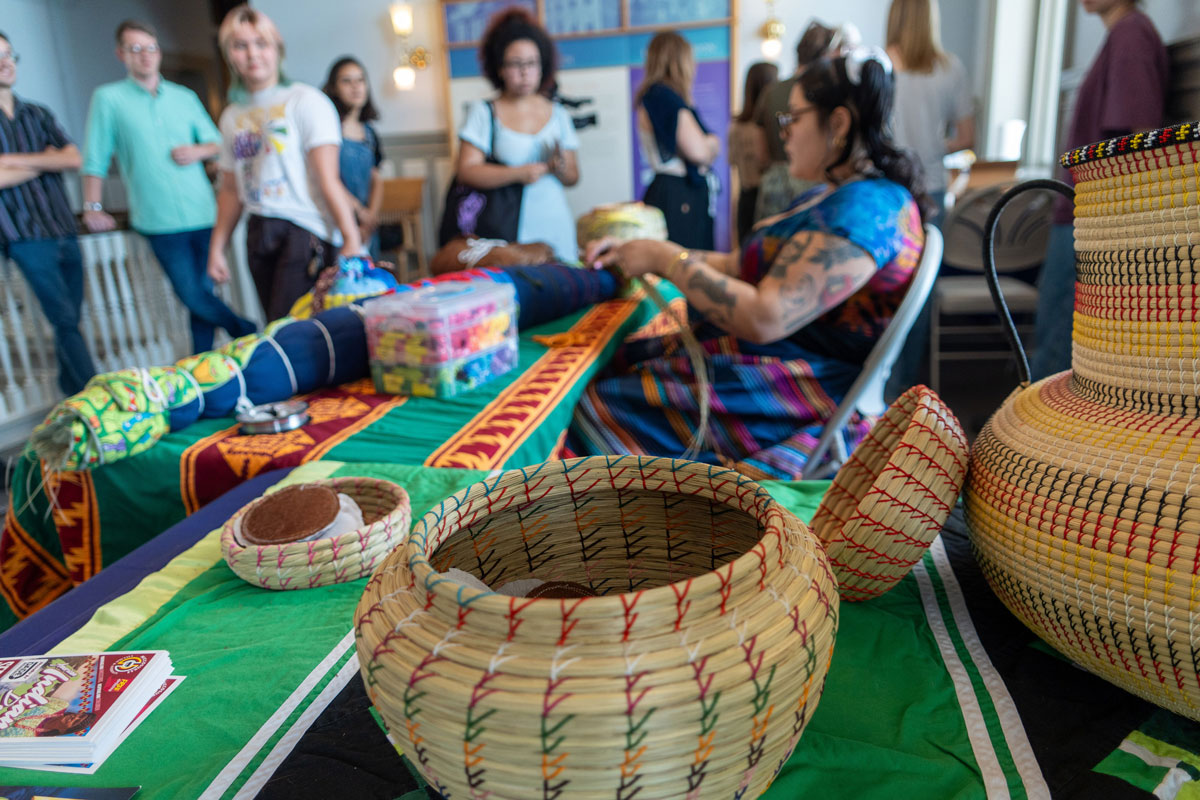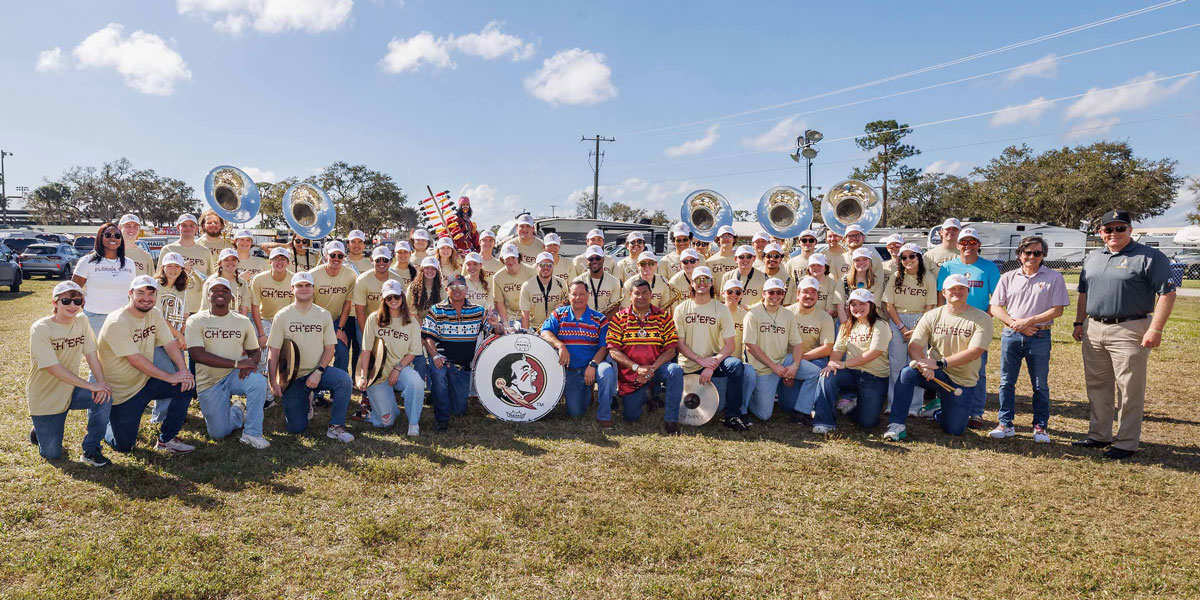Path to Partnership
The Native American and Indigenous Studies Center partnered with the Florida Historic Capitol Museum to host two Seminole artists and one Miccosukee artist. After an evening discussion, they spent the day demonstrating their artwork for the public, September, 2024.
Origins
In 1947, shortly after FSU became a coeducational institution, the FSU student body voted to become known as the “Florida State Seminoles.” It chose the name without the permission or participation of the Florida Seminoles. The student body called its first homecoming “Pow Wow,” and began to crown a homecoming princess and chief. The university imprinted bows and arrows, tomahawks, feathers, teepees, and other stereotypically indigenous images across the university.
Other iconography on campus similarly bore little or no resemblance to the actual Florida Seminoles. A student literary magazine was called “Smoke Signals” and the homecoming court wore feathered war bonnets. This tradition, which reflects a sacred tradition among many western Native American tribes, is illustrated by the depiction of Doby Flowers (FSU's first African-American homecoming princess) seen on FSU’s Integration Statue.
Early Consultation
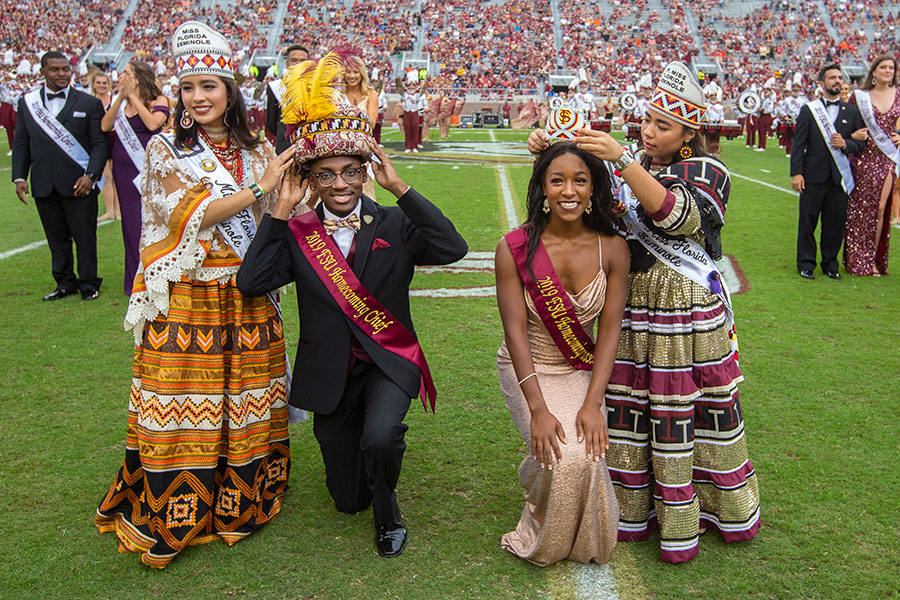
The Florida Seminoles were recognized by the U.S. government in 1957 as the Seminole Tribe of Florida. Many years later, informal conversations and formal consultations with the Seminole Tribe, as well as student and public protests, convinced FSU to change how it depicted Seminoles. FSU increasingly invited Seminoles to attend campus functions, having them serve as dignitaries at various events and recognizing their achievements with honorary degrees. FSU also slowly acknowledged that its earlier representations were ill-suited to represent a modern university.
In 1972, for the first time, Florida Seminoles attended homecoming festivities as official representatives of the tribe. The delegation included Miss Florida Seminole, an official spokeswoman for the tribe, who has crowned the homecoming court at FSU ever since. The annual delegation has typically included elected Tribal officials (usually the chairman or chairwoman) as well as family members of Miss Florida Seminole and now Jr. Miss Florida Seminole.
The presence of Seminole Tribal members on campus made an immediate impact on university iconography and traditions. Since then, the Seminole presence and influence on campus has increased. In 1975, Chairman Howard Tommie served as an honorary member of the Homecoming Steering Committee. The following year, at the direction of Tribal members, FSU changed the homecoming headwear to Seminole turbans rather than headdresses. Each year since, Tribal members make these items and present them to what eventually became known as the homecoming chief and princess. Finally, in 1978, in consultation with the Seminole Tribe of Florida and in particular with Chairman Howard Tommie, the university began the Osceola and Renegade tradition.
Toward a Partnership
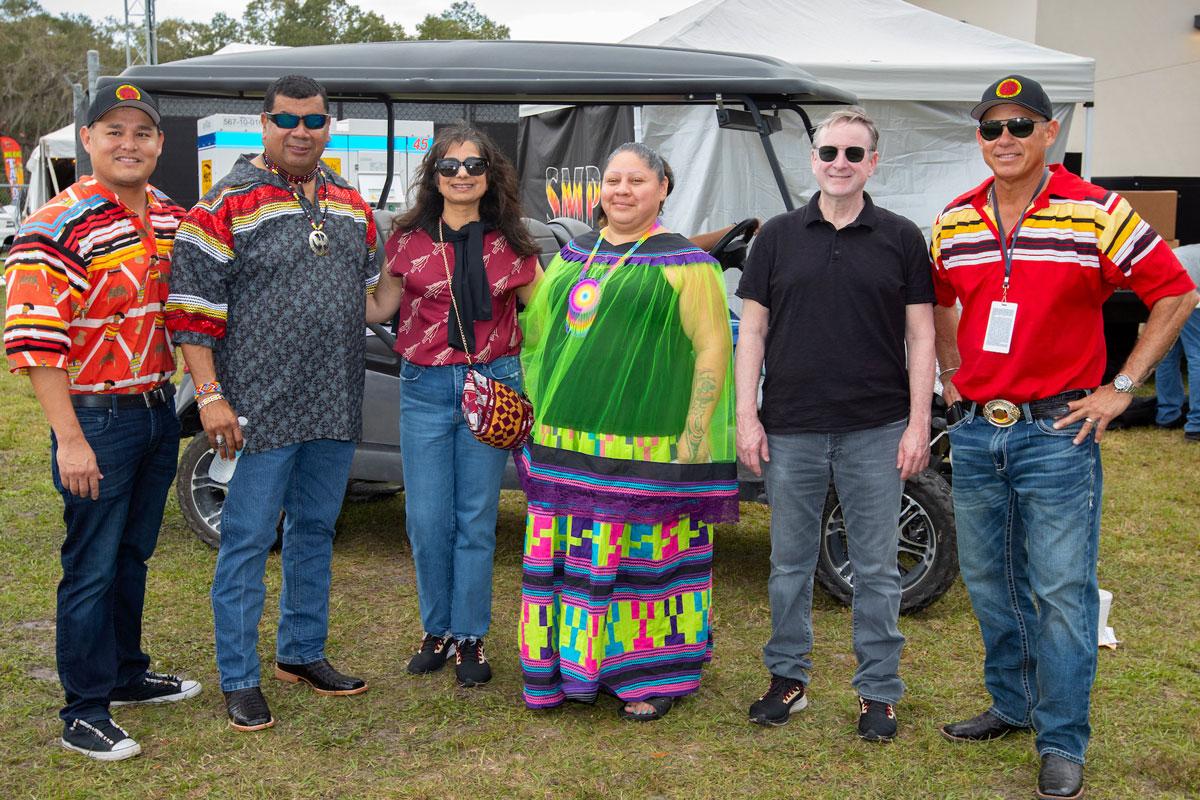
FSU President Richard McCullough and First Lady Dr. Jai Vartikar visit with Seminole Tribe members Kyle Doney, Brighton Councilman Larry Howard, Big Cypress Councilwoman Mariann Billie, and Hollywood Councilman Christopher Osceola, February 17, 2024.
In 1982, as a national debate over the use of Native American names and images continued, FSU officially began to examine its own behavior. When word of these conversations reached the public, Seminole Chairman James E. Billie insisted that only the sovereign Seminoles had the right to make this determination and declared that he would let FSU know if he or the Tribe was offended. This insistence on the sovereign right of the Seminoles to speak for themselves still shapes how FSU treats its use of the Seminole name.
In the early 1990s, when protestors returned to Tallahassee on game days, the Seminole Tribe of Florida remained supportive of FSU and its use of the Seminole name and images. In 1991 Chairman James E. Billie publicly endorsed FSU's use of the name "Seminoles" in a letter to the FSU Alumni Association. Once again, the Tribe insisted that it had the right to speak for itself.
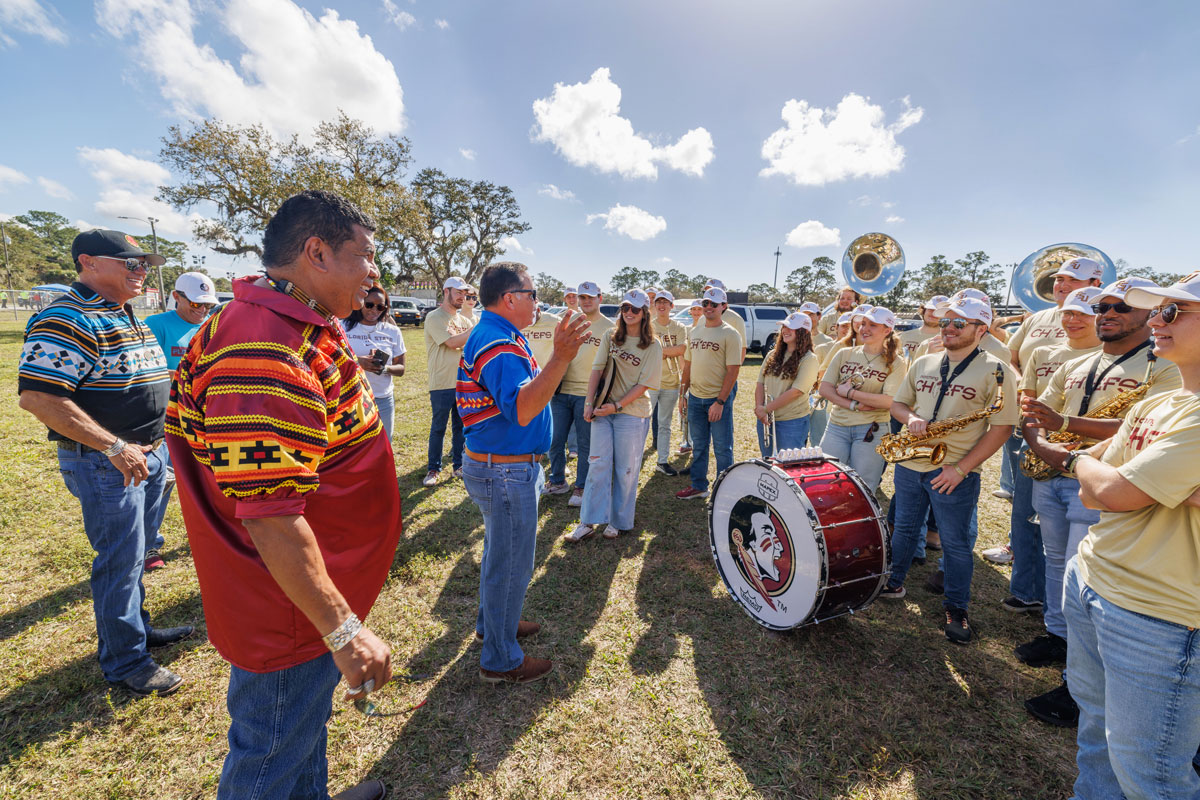
STOF Chairman Marcellus Osceola welcomes The Marching Chiefs to the 2025 Brighton Field Days Festival, February 2025.
Seminoles did more than sanction FSU’s use of their name. They continued to shape FSU’s public portrayal and their presence on campus increasingly moved beyond athletics. In 1994, the university awarded an honorary doctorate to Seminole Betty Mae Tiger Jumper, the first woman to be elected chair of a federally recognized tribe in the United States and a pioneer in Tribal health. In 2003, the university unveiled the Unconquered Statue. The statue, and the subsequent “unconquered Seminole” campaign at FSU, recognized the resilience of the Seminoles who have long called themselves the “unconquered tribe.”
The NCAA resolution of 2005
In 2005, a new NCAA policy brought renewed national attention to the use of Native American names. The Seminole Tribe of Florida asserted the rights of the Seminoles to speak for themselves. In the end, the Tribal Council passed a resolution that supported FSU's continued use of the Seminole name and associated images. The resolution, in many ways, mirrored Billie’s earlier insistence that the Seminoles have a sovereign right to speak on the issue. The resolution of the Tribal Council convinced the NCAA to allow Indigenous communities to sanction the use of their name, an exception that only a handful of universities enjoy.
In the immediate wake of the resolution, FSU and the Tribe renewed their efforts to strengthen their relationship. Seminole Tribal members constructed traditional chickee buildings on the FSU campus, the university created new curriculum to teach Seminole history and culture, and FSU commissioned and unveiled the “The Seminole Family” statue on campus. It also bestowed an honorary Doctor of Laws degree on Seminole Tribal member and General Counsel Jim Shore. Just as importantly, university administrators began to emphasize the responsibility that FSU’s community had in upholding the relationship. Many student traditions were abandoned as the university considered what it meant to honor their partnership with the Tribe.
Contemporary
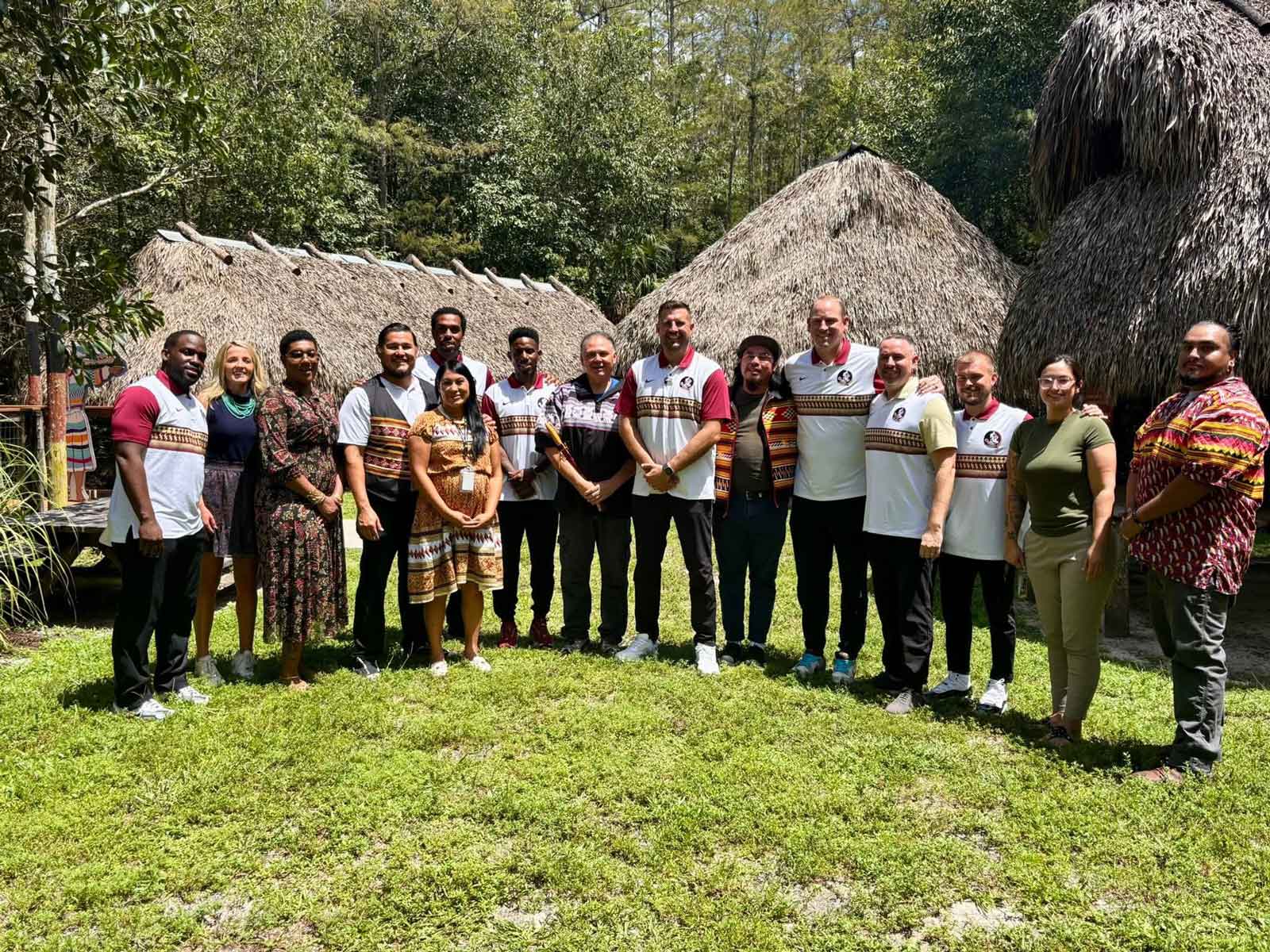
FSU Men’s Basketball coaches and staff, including head basketball coach Luke Loucks, visit with members of the Seminole Tribe of Florida at Big Cypress Reservation, September 2025.
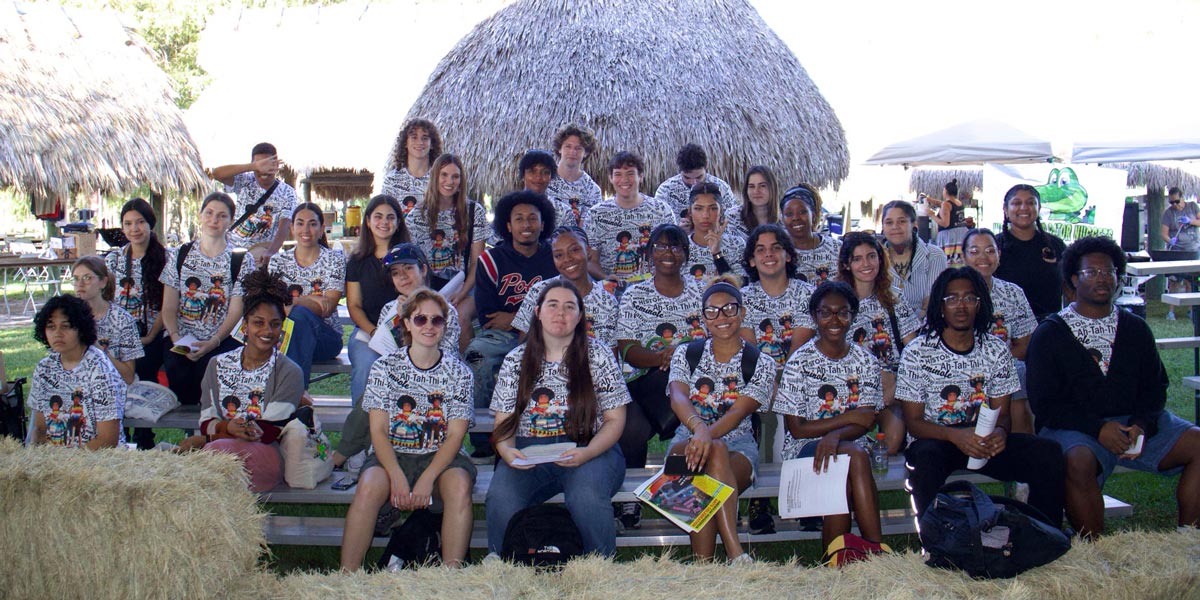
FSU student volunteers visit Big Cypress Reservation during the Seminole Tribe of Florida’s annual American Indigenous Arts Celebration, November 2025. (Courtesy Sam Austin)
In recent years, the university has worked with Tribal members to reimagine many elements of campus. University representatives began to attend Tribal events on Seminole reservations in South Florida, and the FSU President and Tribal Chairman began to hold regular consultations. In 2012, with the help of the Tribe, the university redesigned many athletic uniforms to include monochromatic replicas of the Seminole’s distinctive patchwork clothing. In 2013, FSU reimagined its Cultural Graduation Ceremony with the help of the Seminole Tribe of Florida to include references to Seminole culture and history. As part of the changes, the name of the ceremony was changed to the V-rak-ke-che-tv Cultural Graduation Ceremony. V-rak-ke-che-tv means honor in the Seminole language. Similarly, the university now holds an Estonko ceremony each fall as a way to welcome students to campus and introduce them to the importance of the Seminole’s Council Oak. In 2014, FSU honored Seminole Tribal member Louise Gopher (the Westcott Award recipient in 2007) with an honorary PhD, a testament to her lifelong commitment to Tribal education.
As the university has worked to create more appropriate imagery and connections on campus, it has also eliminated other traditions. In 2021, the students renamed Pow Wow to Homecoming Live and more recently renamed the FSU Reservation (the Rez) to Lakefront Park.
Today, Florida State University and the Seminole Tribe of Florida are partners who work side by side to ensure that use of their name and iconography is done with respect and permission. FSU and the Tribe continue to collaborate and ensure that the relationship is built on mutual respect and friendship. Every FSU student, alumnus, and fan is responsible for maintaining and respecting this relationship.
The Seminole Tribe of Florida's leadership and Provost Jim Clark with The Marching Chiefs and Osceola & Renegade at the 2025 Brighton Field Days Festival, February 2025.

